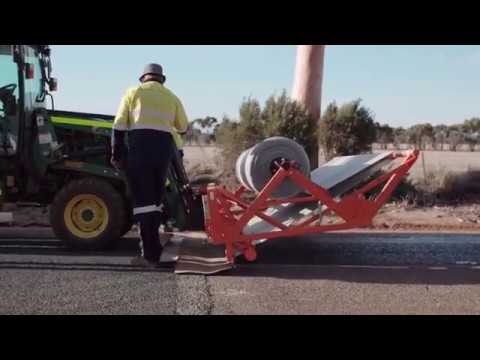Paving fabric is a revolutionary solution for enhancing the durability and longevity of road surfaces. Designed to strengthen, protect, and extend the life of asphalt pavements, this innovative material offers unmatched benefits. With its high-strength synthetic fibers, the fabric acts as a reinforcement layer, preventing cracking and rutting caused by heavy traffic loads and weathering. Its unique permeability allows water to drain through the pavement, reducing the risk of standing water and prolonging the lifespan of the road. Additionally, this cost-effective fabric is easy to install, making it an ideal choice for both new construction and pavement rehabilitation projects. By incorporating paving fabric into your road infrastructure, you can significantly reduce maintenance costs while ensuring a smooth and resilient driving experience for years to come. Discover the power of paving fabric today and transform your roads into long-lasting, sustainable assets.

The Advantages of Paving Fabric in Road Construction
In the world of road construction, paving fabric has become a game-changer. This innovative material has been widely adopted due to its numerous benefits and cost-effectiveness. In this article, we will explore the advantages of using paving fabric in road construction.
1. Enhanced Durability and Longevity
Paving fabric is a geotextile material made from polyester or fiberglass. It acts as a barrier between the existing road surface and the new overlay, preventing cracks and potholes from forming. By reinforcing the pavement, it significantly enhances the durability and longevity of the road.
When installed correctly, paving fabric can extend the lifespan of a road by up to 50%. It prevents water infiltration, which is one of the main causes of pavement failure. By reducing water damage, the road can withstand heavy traffic and environmental stresses for a much longer period.
2. Cost Savings
One of the key advantages of using paving fabric is its cost-effectiveness. While the initial investment might be higher than traditional methods, the long-term savings make it a smart choice for road construction projects.
The extended lifespan of the road means fewer repairs and maintenance, resulting in substantial cost savings over time. Additionally, the prevention of cracks and potholes reduces the need for costly rehabilitation and resurfacing, further minimizing expenses.
3. Improved Safety and Performance
Another significant advantage of paving fabric is its ability to enhance the safety and performance of roads. By providing a strong reinforcement layer, it minimizes the risk of pavement failures, such as rutting and cracking, which can lead to accidents.
Furthermore, paving fabric creates a smoother road surface, reducing road noise and improving ride quality. This results in a more comfortable driving experience and better fuel efficiency for vehicles.
4. Easy Installation
When it comes to road construction, time is of the essence. Fortunately, paving fabric offers a quick and straightforward installation process, minimizing road closure times and traffic disruptions.
The fabric is applied as a continuous layer over the existing road surface, eliminating the need for extensive excavation and reconstruction. This not only saves time but also reduces the environmental impact of the construction process.
5. Versatility and Adaptability
Paving fabric is highly versatile and can be used in a variety of road construction projects. Whether it's a highway, residential street, or parking lot, this material can be tailored to meet specific requirements.
It can be used in combination with different overlay materials, such as hot mix asphalt or chip seal, providing flexibility and adaptability. Moreover, paving fabric can be applied to both new construction and rehabilitation projects, making it a valuable asset for road engineers and contractors.
In conclusion, paving fabric is a revolutionary material that offers numerous advantages in road construction. Its ability to enhance durability, reduce costs, improve safety, and provide easy installation makes it an ideal choice for modern pavement projects. With its versatility and adaptability, it has undoubtedly become a vital component in the construction and maintenance of roads.
Revolutionizing Road Construction: The Sealmac Paving Fabric Success Story
Video Source : Geofabrics Australasia
Paving Fabric
Paving Fabric
Paving fabric, also known as geotextile paving fabric, is a crucial component in modern road construction. It is an engineered textile material that is used to enhance the performance and lifespan of pavements. This non-woven fabric is specifically designed to provide reinforcement, separation, filtration, and drainage capabilities to road surfaces, making them more durable and resistant to deterioration caused by traffic loads, moisture, and environmental factors.
| Type | Benefits | Applications |
|---|---|---|
| Woven Paving Fabric | – High tensile strength for superior reinforcement – Excellent separation properties to prevent intermixing of base and subbase materials – Enhances pavement stability and reduces rutting – Improves load distribution and minimizes reflective cracking |
– Highway construction – Airport runways – Parking lots – Industrial yards |
| Non-woven Paving Fabric | – Exceptional water permeability for effective drainage – Provides excellent filtration to prevent clogging of underlying layers – Enhances pavement life by reducing fatigue cracking – Resistant to biological degradation and chemical attack |
– Urban roadways – Residential streets – Bike paths – Recreational areas |
| Composite Paving Fabric | – Combines the benefits of both woven and non-woven fabrics – Offers enhanced tensile strength and filtration capabilities – Ensures optimal pavement performance and longevity |
– Heavy-duty roadways – Ports and terminals – Intersections – High-stress areas |
Paving fabric is a cost-effective solution that significantly extends the lifespan of pavements, reducing the need for frequent repairs and maintenance. It acts as a barrier, protecting the pavement layers from each other and preventing the intrusion of fine particles that can weaken the structure over time. The use of paving fabric promotes sustainability in road construction by improving the resilience and longevity of pavements, ultimately leading to reduced environmental impact and economic savings.
